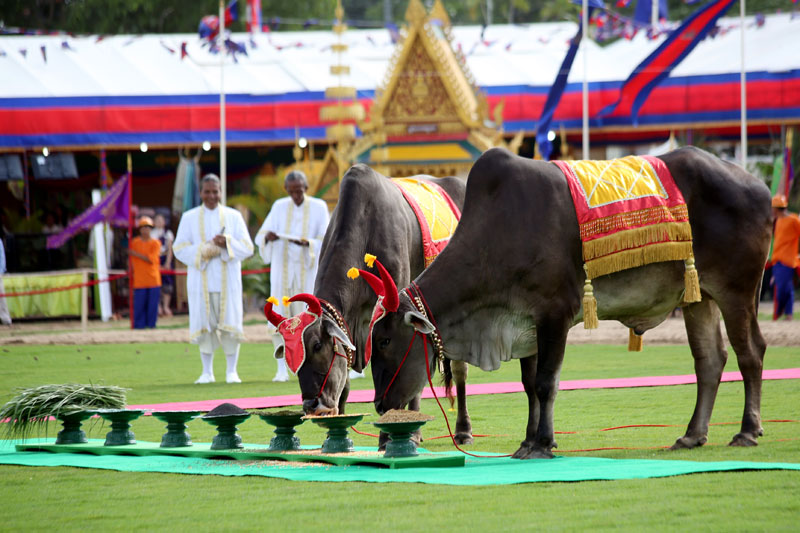TAKHMAO CITY, Kandal province – After circling the field inside the sports stadium here three times, a pair of oxen, being watched by King Norodom Sihamoni and about 500 others on Saturday, were led to seven bowls containing rice, corn, sesame seeds, beans, freshly cut grass, water and rice wine.
One ox delved straight into the bowl containing beans, the other briefly sniffed the grass before settling on some corn. Both went on to sample a few mouthfuls of rice.

In the annual tradition of the Royal Plowing Ceremony, held for palace astrologers and Brahmin priests to foretell the outcome of the year’s harvest, the oxen’s culinary choice predicts a decent harvest of beans, corn and rice in 2014.
“The royal cows ate beans, corn and rice and so there will be a moderate yield this year,” Brahmin priest Korng Ken announced over loudspeakers at the stadium, to the relief of spectators and more than 1,000 others gathered outside the stadium.
While still a widely followed cultural event, farmers and other spectators in Takhmao were divided on how much the oxen’s taste would determine the agricultural prospects for the season ahead.
“The royal oxen ate beans, corn and rice so I think beans, corns and rice will have a good yield,” said Nheuk Ny, 53, a farmer from Kandal province’s Sa’ang district.
Chea Tang, 78, who said she has attended some 30 plowing ceremonies since the 1960s, was just relieved that the oxen weren’t thirsty.
“If the royal oxen drank wine, the crop yield would not be good,” Ms. Tang said. “From my experiences, if the royal oxen drinks water, there will be flooding.”
A look to recent ceremonies suggests that the royal oxen have a particular penchant for corn and beans.
Last year, one ox nibbled on corn while the other settled on grass from the Kompong Cham football pitch, where the event was held. Corn and beans were also among the crops of choice in 2012 and 2010.
Brahmin priest Soeng Piseth, one of three astrologers who was part of the procession, said the predictability of the cow’s appetite was simply a reflection of the country’s consistent agricultural output.
“Every year our country has no shortage of these crops like corn, bean and rice. We even export to overseas,” he said. “So this result is pretty good.”
However, Chim Kimhor, 24, a student at Kandal provincial teacher training college and one of the royal servants at Saturday’s ceremony, said that farmers had bigger problems to worry about with global warming, and said they should take fate into their own hands.
“For me, I only believe 50 percent [in the plowing ceremony] because right now the weather in Cambodia, and around the world, is changing,” Mr. Kimhor said. “It’s not the same as the past, when there could be more accuracy.
“I would like to tell the people that this is just the ancient and traditional ceremony.
“We still believe the same as before, but we have to find methods to increase our agricultural yield through modern irrigation systems.
“Even in the past, Khmer kings also focused on the irrigation systems, so we do not have to rely only on the rain.”




